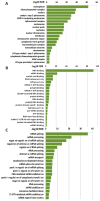New Functions of Intracellular LOXL2: Modulation of RNA-Binding Proteins
- PMID: 37298909
- PMCID: PMC10254187
- DOI: 10.3390/molecules28114433
New Functions of Intracellular LOXL2: Modulation of RNA-Binding Proteins
Abstract
Lysyl oxidase-like 2 (LOXL2) was initially described as an extracellular enzyme involved in extracellular matrix remodeling. Nevertheless, numerous recent reports have implicated intracellular LOXL2 in a wide variety of processes that impact on gene transcription, development, differentiation, proliferation, migration, cell adhesion, and angiogenesis, suggesting multiple different functions for this protein. In addition, increasing knowledge about LOXL2 points to a role in several types of human cancer. Moreover, LOXL2 is able to induce the epithelial-to-mesenchymal transition (EMT) process-the first step in the metastatic cascade. To uncover the underlying mechanisms of the great variety of functions of intracellular LOXL2, we carried out an analysis of LOXL2's nuclear interactome. This study reveals the interaction of LOXL2 with numerous RNA-binding proteins (RBPs) involved in several aspects of RNA metabolism. Gene expression profile analysis of cells silenced for LOXL2, combined with in silico identification of RBPs' targets, points to six RBPs as candidates to be substrates of LOXL2's action, and that deserve a more mechanistic analysis in the future. The results presented here allow us to hypothesize novel LOXL2 functions that might help to comprehend its multifaceted role in the tumorigenic process.
Keywords: EMT; LOXL2; RNA-binding proteins; intracellular LOXL2; nuclear interactome.
Conflict of interest statement
The authors declare no conflict of interest.
Figures





Similar articles
-
Lysyl oxidase-like 2 is a regulator of angiogenesis through modulation of endothelial-to-mesenchymal transition.J Cell Physiol. 2019 Jul;234(7):10260-10269. doi: 10.1002/jcp.27695. Epub 2018 Nov 1. J Cell Physiol. 2019. PMID: 30387148 Free PMC article.
-
LOXL2 in cancer: regulation, downstream effectors and novel roles.Biochim Biophys Acta Rev Cancer. 2020 Dec;1874(2):188435. doi: 10.1016/j.bbcan.2020.188435. Epub 2020 Sep 22. Biochim Biophys Acta Rev Cancer. 2020. PMID: 32976981 Review.
-
LOXL2 in epithelial cell plasticity and tumor progression.Future Oncol. 2012 Sep;8(9):1095-108. doi: 10.2217/fon.12.105. Future Oncol. 2012. PMID: 23030485 Review.
-
MCF-7 cells expressing nuclear associated lysyl oxidase-like 2 (LOXL2) exhibit an epithelial-to-mesenchymal transition (EMT) phenotype and are highly invasive in vitro.J Biol Chem. 2013 Oct 18;288(42):30000-30008. doi: 10.1074/jbc.C113.502310. Epub 2013 Sep 6. J Biol Chem. 2013. PMID: 24014025 Free PMC article.
-
Specific protein 1(SP1) regulates the epithelial-mesenchymal transition via lysyl oxidase-like 2(LOXL2) in pancreatic ductal adenocarcinoma.Sci Rep. 2019 Apr 11;9(1):5933. doi: 10.1038/s41598-019-42501-6. Sci Rep. 2019. PMID: 30976063 Free PMC article.
Cited by
-
LOXL2 in Cancer: A Two-Decade Perspective.Int J Mol Sci. 2023 Sep 21;24(18):14405. doi: 10.3390/ijms241814405. Int J Mol Sci. 2023. PMID: 37762708 Free PMC article. Review.
-
A Comprehensive Review of Protein Biomarkers for Invasive Lung Cancer.Curr Oncol. 2024 Aug 23;31(9):4818-4854. doi: 10.3390/curroncol31090360. Curr Oncol. 2024. PMID: 39329988 Free PMC article. Review.
-
Crosstalk of lysyl oxidase-like 1 and lysyl oxidase prolongs their half-lives and regulates liver fibrosis through Notch signal.Hepatol Commun. 2024 Mar 11;8(4):e0391. doi: 10.1097/HC9.0000000000000391. eCollection 2024 Apr 1. Hepatol Commun. 2024. PMID: 38466882 Free PMC article.
-
Editorial on the Themed Issue in Honor of Carlos Gutiérrez Merino: Forty Years of Research Excellence in the Field of Membrane Proteins and Bioenergetics.Molecules. 2025 Apr 11;30(8):1710. doi: 10.3390/molecules30081710. Molecules. 2025. PMID: 40333596 Free PMC article.
-
The Versatility of Collagen in Pharmacology: Targeting Collagen, Targeting with Collagen.Int J Mol Sci. 2024 Jun 13;25(12):6523. doi: 10.3390/ijms25126523. Int J Mol Sci. 2024. PMID: 38928229 Free PMC article. Review.
References
MeSH terms
Substances
Grants and funding
LinkOut - more resources
Full Text Sources
Medical

